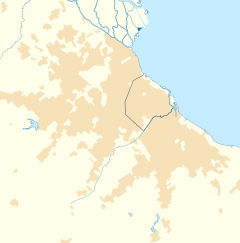General Pacheco facts for kids
Quick facts for kids
General Pacheco
|
|
|---|---|
| Country | |
| Province | |
| Partido | Tigre |
| Founded | Approx 1880 |
| Elevation | 11 m (36 ft) |
| Population
(2001 census [INDEC])
|
|
| • Total | 43,287 |
| CPA Base |
B 1617
|
| Area code(s) | +54 11 |
General Pacheco is a city in Argentina. It is part of the Tigre Partido area, which is a large group of cities near Buenos Aires. In 2001, about 43,287 people lived in General Pacheco. This made it the second most populated city in the Tigre area.
The city is about 38 kilometers (24 miles) north of downtown Buenos Aires. It is also very close to the Pan American Highway.
Economy of General Pacheco
General Pacheco is an important place for many businesses. There are several big factories here. These include car factories like Ford Motor Argentina and Volkswagen. There is also a large food company called Kraft Foods.
The Techint Group also has an industrial plant in the city. In total, General Pacheco has 161 factories. These factories provide jobs for about 7,135 workers.
The city is also home to a special radio station. The shortwave transmitter for Radiodifusión Argentina al Exterior is in General Pacheco. This station sends radio waves that can be heard all around the world!
Car Manufacturing
General Pacheco is a key location for making cars in Argentina. Both Ford Motor Argentina and Volkswagen have factories here. Other big car companies in Argentina include CIADEA, Sevel, General Motors, FIAT, Toyota, and Autolatina.
Autolatina is one of the largest car makers in Argentina. The car manufacturing industry in Argentina is very big. It has about 400 companies and employs 35,700 people. This industry helps the country's economy a lot.
The famous Ford Falcon car was made in General Pacheco. Ford started making the Falcon in Argentina in 1965. They continued to produce it until 1991. When the Pacheco Stamping and Assembly plant opened, Argentina became a major car exporter.
These large car factories need many workers. Most of the workers at the Ford plant had a high school education. About one-third had a university degree. These plants often hire young, educated workers. Many workers start in the car industry around age 23. They might have worked in farming before this.
To make cars, workers need special skills. So, schools and training programs are very important. For example, the Henry Ford Technical School is in General Pacheco. It teaches students technical skills for the car industry. This helps prepare them for jobs in these factories.
Food Production
The main factory for Kraft Foods Argentina (KFTA) is in General Pacheco. This factory makes many popular food products.
In 2009, there was a health issue that affected the factory. Some workers got sick with the H1N1 flu. This led to some problems between the workers and the company. About 150 workers were temporarily out of work.
The workers asked for higher pay and time off to avoid the flu. The company did not agree to these requests. This led to a protest on the Pan American Highway. Some workers were removed by the police.
Sometimes, workers in factories face challenges with their jobs. They might worry about losing their jobs. Because of this, workers sometimes form groups to ask for better conditions. They hope to make positive changes in their workplaces. This can help them get fair treatment and better pay.
See also
 In Spanish: General Pacheco para niños
In Spanish: General Pacheco para niños


